Determining Critical Speed
Critical speed is the angular velocity at which the screw (or nut) develops severe vibrations. Regardless of mounting orientation, a ball screw assembly must operate below its critical speed to avoid vibration, noise and possible failure. The magnitude and location of the shaft unbalance, the length of the shaft, shaft diameter, and the type of bearing support are factors which affect critical speed.
Determining Ball Screw Life
The useful life of a ball screw assembly, usually given in terms of one million inches of travel. The operational load rating is a major determinate of ball screw life. Every application is unique; duty cycle and environment also have an effect. Customers are encouraged to consult with our engineering staff to discuss the specific requirements of their applications.
Determining Ball Screw Load
The amount of load to be moved is used to select the proper screw size.
Vertical load move: The nut load is equal to the weight to be moved plus the friction load.
Horizontal load move: The nut load is determined by multiplying the weight by the coefficient of friction.
Loads can also be measured with a spring scale or dynamometer, which is recommended for loads that are neither vertical or horizontal. The higher the load, the larger the size of the screw and nut is needed. The load capacity of a ball screw can be increased by increasing screw diameter, nut length, quantity of internal balls or ball diameter.
Lead Error Standards
Lead error refers to the error in lead length per turn, compared to the basic lead specified. We manufacture ground ball screws up to ANSI Class 2 or DIN/JIS Class 1 specification.
| Standard | Specification |
| ANSI C2, DIN/JIS C1 | 0.0002 in/ft or 5 μm/300mm |
| ANSI C5, DIN C3 | 0.0005 in/ft or 12 μm/300m |
| ANSI C7, DIN C5 | 0.001 in/ft or 25 μm/300mm |
| ANSI C8 | 0.006 in/ft or 150 μm/300mm |
Ball Screw Cause/Effect Considerations
The following chart indicates the relationship between various design specifications and operation parameters.
| INCREASE IN: | AFFECTS: | HOW: |
| Screw Length | Critical Speed | Decreases |
| Column Load | Decreases | |
| Screw Diameter | Critical Speed | Increases |
| Inertia | Increases | |
| Stiffness | Increases | |
| Load Capacity | Increases | |
| Column Load | Increases | |
| Lead | Torque | Increases |
| Load Capacity | Decreases | |
| Positioning Accuracy | Decreases | |
| Angular Velocity | Decreases | |
| Angular Velocity | Critical Speed | Decreases |
| Mounting Rigidity | Critical Speed | Increases |
| System Stiffness | Increases | |
| Load | Life | Decreases |
| Nut Length | Load Capacity | Increases |
| Stiffness | Increases | |
| No. of Balls | System Stiffness | Increases |
| Load Capacity | Increases | |
| Preload | Positioning Accuracy | Increases |
| System Stiffness | Increases | |
| Drag-Torque | Increases | |
| Ball Diameter | Life | Increases |
| Stiffness | Increases | |
| Load Capacity | Increases | |
| Lead | Increases |
Ball Screw Assembly
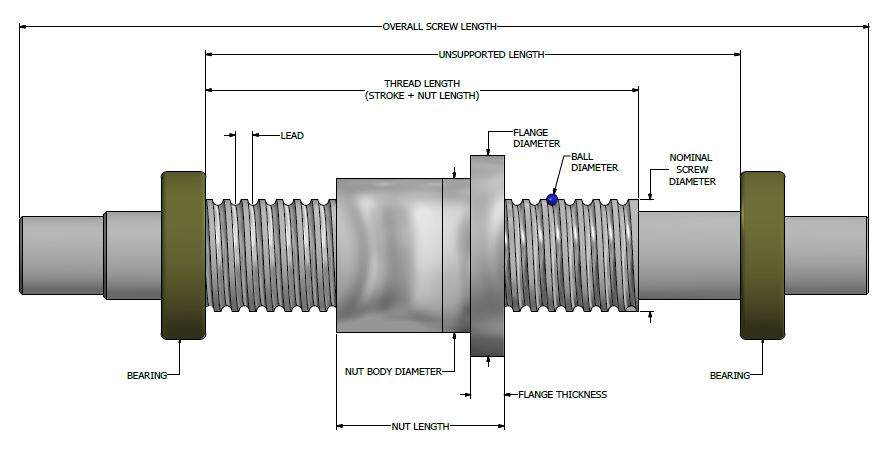
Ball Screw Mounting & Ball Nut Styles
Ball Screw Mounting Styles: Four standard mounting styles are available. Fixed ends offer the highest column load support and the highest resistance to vibration.
Fixed-Free

Fixed-Support

Support-Support

Fixed-Fixed

Ball Nut Styles: For standard ball nut styles are available. Internal and external returns can be applied to all styles.
Single Nut (1 piece)
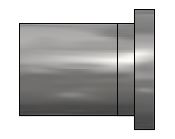
Middle Flange Nut (1 piece)
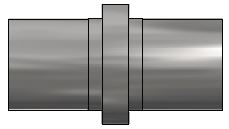
Double Nut (2 pieces)
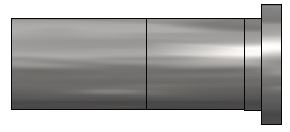
Flange to Flange Nut (2 pieces)
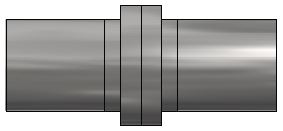
Ball Screw Customization
Your ball screw will be configured with the options you specify, and can be further customized for a complete turn-key solution that is quick and easy to install, saving you time and money. Customization options:
- Ball nut configuration (single or double nut, 2-piece flange to flange nut, middle flange nut)
- Internal or external ball returns
- Wipers & End Seals
- Custom journal ends (view typical journal end specs)
- Custom housing & mounting blocks


